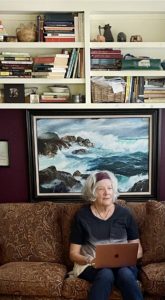A Tale of Two Remarkable Women: Interview with the author of The Lady with the Crown: A Story of Resilience by Helen Gibbons
Bay Area native Kathleen Canrinus wrote The Lady with the Crown: A Story of Resilience to honor her mother, Dorothy. When Kathleen was 15, her mother suffered a traumatic brain injury in a car accident. After three months in a coma, Dorothy emerged partially paralyzed and cognitively impaired, upending the life of her family.

Kathleen’s memoir focuses on the relationship between mother and daughter, particularly its evolution during the 54 years between Dorothy’s accident and her death at age 99. There were plenty of challenges, but also lots of laughter and, oh, so much love. It’s a story I will enjoy reading again and again, finding some new insight or well-crafted sentence to relish each time.
I met Kathleen in 2006 when we both joined the World Harmony Chorus in Mountain View, California, and our conversations over the years have focused mostly on music. I wanted to learn more about Kathleen’s writing life and in particular The Lady with the Crown. We exchanged some emails and then sat down to talk. Our conversation is edited and condensed.
Helen: When did you start thinking of yourself as a writer?
Kathleen: I came to writing late in life, that is, after I retired from teaching elementary school. When I signed up for my first writing class, I had in mind writing stories from my life and wanted to tell them well. Even though I have now written a book that was published, and numerous personal essays too, I still hesitate to introduce myself to a stranger as a writer. But as far as thinking of myself as a writer, that came in the first few years of writing seriously, when I discovered that I was a person who noticed and remembered things, that I could write an occasional beautiful sentence, that I had a sense of how to shape a story, and most importantly, that finding words to match experience brought with it a thrill like nothing else. Writing lends meaning and purpose to my life. I like the Joan Didion quote: “I write to find out what I’m thinking.”
Helen: How did The Lady with the Crown come to be?
Kathleen: The Lady with the Crown evolved from stories I wrote about my mother over a decade in various writing workshops and classes. My mother had a remarkable attitude about life in spite of epic reversals. She was funny too—good material. I was never writing about her for family alone but for people like my classmates and possible future readers who didn’t know her. I intended to honor her and others who live small lives with dignity and courage. Although I wrote about other topics like friendship, marriage, and aging, the response to the mother stories was the most positive. I planned to string them together in a book and had finished most of them when the editor at a small press offered me a contract.
Helen: What a great opportunity! What happened next?
Kathleen: Next I spent nine months finishing a manuscript. Everything I had already written needed to be revised and new chapters added to complete the story. My editor made a lot of suggestions that improved the book.
Helen: Can you share examples?
Kathleen: When I originally thought about doing a book, I thought I would take the stories I had written about my mother and link them very loosely, like the stories in Olive Kitteridge [a novel by Elizabeth Strout that is a collection of interrelated stories]. I thought that approach would make my task easy. But when I told the editor, she said, “No, no, no! Make it one story. And whether you like it or not,” she added, “you’re the main character. You need to put yourself into this story; you’re not just the witness.”
